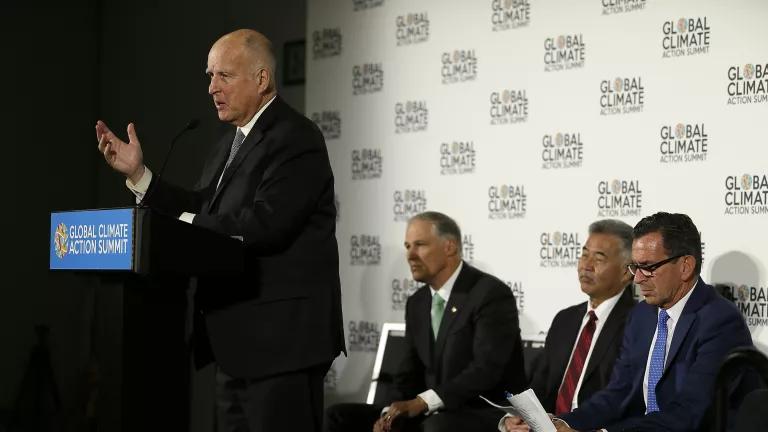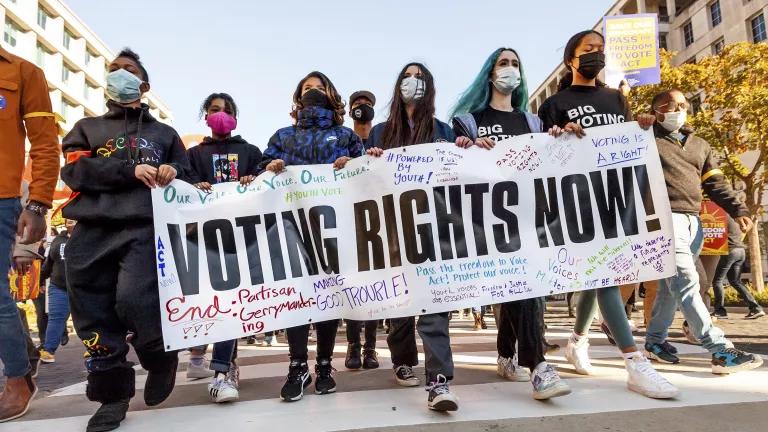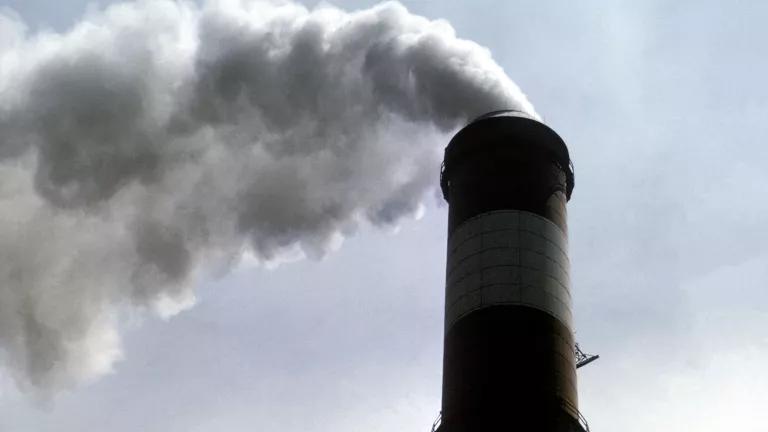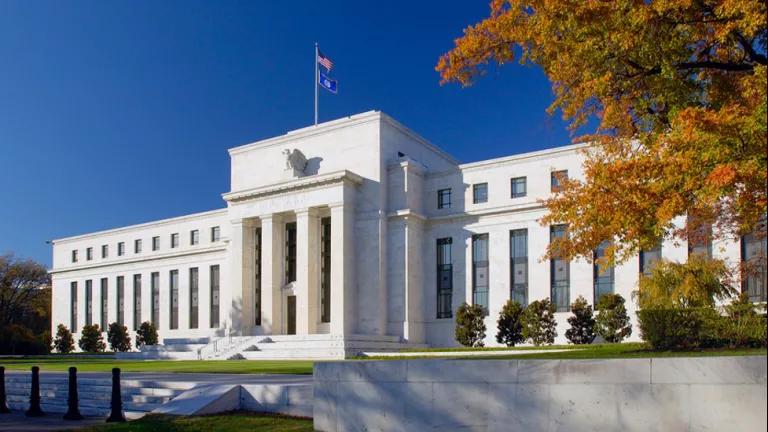The Message from Last Week’s Climate Summit Is Clear
In San Francisco, leaders made unprecedented commitments to fighting global climate change, invigorating the movement, and sending a strong signal to President Trump that, despite his efforts, he won’t stop our progress.

California governor Jerry Brown at a news conference during the Global Climate Action Summit; in the background (from left): Washington governor Jay Inslee, Hawaii governor David Ige, and Connecticut governor Dannel Malloy
Eric Risberg/Associated Press
In San Francisco, leaders made unprecedented commitments to fighting global climate change, invigorating the movement, and sending a strong signal to President Trump that, despite his efforts, he won’t stop our progress.
The global effort to fight climate change became a tale of two cities last week. In Washington, President Trump pressed his reckless assault on our environment and health. In San Francisco, meanwhile, some 4,000 state, city, tribal, and corporate delegates from around the world rallied around an unprecedented slate of actions to dramatically strengthen efforts to fight the central environmental challenge of our time.
This was more than an environmental gathering. It was the affirmation of an international campaign grounded in purpose and centered on action to advance a vital global mission. We moved the ball forward at the Global Climate Action Summit in San Francisco, and we won’t be turned around.
Much like a climate agreement, a climate summit by itself doesn’t solve all our problems. San Francisco, though, marked a turning point. It rallied the will of a powerful and growing global coalition standing united against the increasing dangers of climate change. Spurred on by thousands of climate activists marching across the nation, the summit energized a movement that’s been cast into question by White House backsliding. And it allowed us to take stock of the progress we’ve made in the years since the 2015 Paris Agreement was inked and build momentum toward 2020, when countries must strengthen their commitment to the goals of the accord.
“Now it’s time to take this momentum back home,” California governor Jerry Brown, who was a cochair at the summit, told delegates in remarks concluding the three-day summit. “Climate change waits for nobody. Let’s get to work.”
Nearly three years after the 2015 Paris climate agreement, we’ve reached a pivotal point in the fight to leave our children a livable world. What we do, or fail to do, in the next two or three years will determine whether future generations inherit climate change or climate catastrophe.
Despite Trump’s efforts to ensure disaster, San Francisco may have righted the ship—and just in the nick of time. Between now and 2030, much of the global economy will, literally, be created anew, with $90 trillion in investment in new bridges, airports, buildings, energy systems, and other critical infrastructure worldwide. This is our moment to build out our vision of a climate-safe world by incorporating the sustainable solutions we know are needed to avert climate chaos.

Johan Rockstrom (left), executive director of the Stockholm Resilience Center, and Christiana Figueres, founding partner of Global Optimism and convener of Mission 2020, presenting during the opening plenary of the Global Action Climate Summit, September
Eric Risberg/Associated Press
Seizing this opportunity to speed the global shift from the dirty fossil fuels that are driving climate change to cleaner, smarter ways to power our future can generate a staggering $26 trillion in economic benefits between now and 2030, spawn more than 65 million clean energy jobs worldwide, and prevent more than 700,000 premature deaths from air pollution in 2030 alone. Those are the real-world findings of the Global Commission on the Economy and Climate, a group of former heads of state and finance ministers from countries like Britain, South Korea, and Norway along with think tanks like the U.S.-based Brookings Institution, dedicated to demonstrating how responsible climate policies can spur a new generation of global growth.
San Francisco showcased those policies in action.
Four states—California, Connecticut, Hawaii, and Washington—pledged a combined $1.4 billion in public funding to help support the use of electric cars. New Jersey announced plans to build offshore wind turbines that could potentially power up to 1.2 million homes. More than 9,000 cities worldwide consolidated plans to cut their carbon footprint. And Los Angeles, Tokyo, Mexico City, and 70 other big cities with a combined population of some 425 million people went even further, pledging to become carbon neutral by 2050. This means they’ll cut their carbon pollution and offset whatever remains by, for example, investing in reforestation or other carbon-reduction measures.
Much of the progress is being driven by the private sector and civil society. Nearly 500 of the world’s largest corporations, collectively generating some $10 trillion in annual revenues, have put plans in place to cut carbon emissions on a scale that aligns with the goals of the Paris accord. Investors and retailers pledged $5.6 trillion to end rainforest destruction in a critical region of Brazil. And Bloomberg Philanthropies, the William and Flora Hewlett Foundation, the Grantham Foundation, and two dozen other philanthropic groups pledged an unprecedented $4 billion over the next five years to support programs to fight climate change.
I’m especially proud of NRDC’s role, at home and abroad, in pressing for the phaseout of a dangerous class of superpollutants called hydrofluorocarbons, or HFCs. Widely used in air conditioners, refrigerators, and aerosol sprays, HFCs are, pound for pound, hundreds of times worse for the climate than even carbon pollution. At the summit, four states—California, Connecticut, Maryland, and New York—unveiled plans to help phase out HFCs, and other states are expected to soon follow their lead.
NRDC also premiered an important new film, Our Ocean Planet. Narrated by Sigourney Weaver, the film lays out, in less than five minutes, the vital link between a stable climate and healthy oceans. Because oceans absorb 90 percent of the global warming caused by climate change, this widening scourge is taking a mounting toll on our seas, marine life, and coastal communities—and all they support.
That’s why it’s important that one of the world’s leading marine research institutions, the University of Hawaii’s Gates Coral Lab, announced plans at the summit to team up with two other groups to help restore Caribbean coral imperiled by warming seas. The pilot project has potential to be expanded to other regions.
Often called the “rainforests of the seas,” coral reefs are among the planet’s most productive habitat. They cover less than 1 percent of the ocean floor yet support about a quarter of all known marine species while providing critical coastal buffer from storms. Rising ocean temperatures, though, are weakening, and even killing, broad reaches of coral reefs worldwide. Between 2015 and 2017, a three-year oceanic heat wave sickened more than 75 percent of the world’s coral reefs and killed off coral at more than a third of them. This kind of mass coral bleaching occurred once every 25–30 years just a generation ago. Now it’s happening every six years and is on track to keep accelerating.
It’s important, too, that Virginia, Hawaii, the city of Seattle, and the Netherlands joined the International Alliance to Combat Ocean Acidification, a growing global consortium dedicated to fighting yet another climate-related crisis in our oceans.
Since the dawn of the industrial revolution, we’ve increased the carbon dioxide levels in the earth’s atmosphere more than 45 percent, chiefly by burning coal, oil, and gas. That, of course, is what’s driven up average global temperatures by about 1.8 degrees Fahrenheit over the past century, about half as much warming, the science tells us, as the earth can manage before the worst impacts of climate change take hold.
About a third of the carbon pollution from burning fossil fuels, though, is absorbed by the earth’s oceans. That’s raising the acidity levels in these waters in ways that threaten shellfish, coral, and species that depend upon them for food and habitat. The world cannot sustain, and our natural systems will not survive, a continuing collapse of our coral systems.
And yet, if our oceans are suffering from climate change, they also hold important keys to the solution. Like giant carbon sponges, forests absorb and store carbon from the atmosphere. Forests of mangroves, which grow in shallow tidal waters, do so at a rate 10 times higher than land forests. In less than a century, though, the world has lost half its mangroves. So it’s important that Apple, the global computer giant based just outside San Francisco, announced plans to help restore 27,000 acres of threatened mangroves along the coast of Colombia.
This is what climate leadership is all about. It’s about laying out a clearheaded vision of a brighter, more hopeful, more prosperous future for our children, across this country and around the world. It’s about seizing the historic economic opportunity to shift to a cleaner, low-carbon global economy. And it’s about demonstrating steady and accelerating progress along the journey toward those goals.
Let’s be clear. This is the kind of leadership we rightly expect at the national level. It’s what we expect from all our leaders. President Trump, though, isn’t simply dragging his feet or trying to bog us down. He’s working to make sure the climate campaign fails. He’s working to defeat the mission. He hasn’t articulated an alternative vision. He doesn’t appear to understand what’s at stake and, for that matter, doesn’t much seem to care. It’s all too clear, though, where Trump’s mad and reckless folly would take us.
It would lock our economy into the fuels of the past, sideline our workers in the economic play of our lifetime, and anchor our future to the dirty fuels of the past. It would allow the hazards and harm of unchecked climate change to fester and worsen and spread. And it would condemn future generations to a world of hardship and ruin we know we can avoid.
That may be where Trump wants to take us, but we’re not going there with him. That’s the message out of San Francisco.



